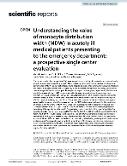Understanding the value of monocyte distribution width (MDW) in acutely ill medical patients presenting to the emergency department: a prospective single center evaluation

Autor
Královcová, Marcela
Müller, Jiří
Hajšmanová, Zdeňka
Datum vydání
2024Publikováno v
Scientific ReportsRočník / Číslo vydání
14 (02 July 2024)ISBN / ISSN
ISSN: 2045-2322ISBN / ISSN
eISSN: 2045-2322Metadata
Zobrazit celý záznamKolekce
Tato publikace má vydavatelskou verzi s DOI 10.1038/s41598-024-65883-8
Abstrakt
The monocyte distribution width (MDW) has emerged as a promising biomarker for accurate and early identification of patients with potentially life-threatening infections. Here we tested the diagnostic performance of MDW in adult patients requiring hospital admission for community-acquired infections and sepsis, evaluated sources of heterogeneity in the estimates of diagnostic accuracy, and assessed the meaning of MDW in a patient population presenting to the emergency department (ED) for acute non-infectious conditions. 1925 consecutive patients were categorized into three groups: non-infection (n = 1507), infection (n = 316), and sepsis/septic shock (n = 102). Diagnostic performance for infection or sepsis of MDW alone or in combination with components of SOFA was tested using AUC of ROC curves, sensitivity, and specificity. The relationship between MDW and different pathogens as well as the impact of non-infectious conditions on MDW values were explored. For the prediction of infection, the AUC/ROC of MDW (0.84) was nearly overlapping that of procalcitonin (0.83), and C-reactive protein (0.89). Statistical optimal cut-off value for MDW was 21 for predicting infection (sensitivity 73%, specificity 82%) and 22 for predicting sepsis (sensitivity 79%, specificity 83%). The best threshold to rule out infection was MDW <= 17 (NPV 96.9, 95% CI 88.3-100.0), and <= 18 (NPV 99.5, 95% CI 98.3-100.0) to rule out sepsis. The combination of MDW with markers of organ dysfunction (creatinine, bilirubin, platelets) substantially improved the AUC (0.96 (95% CI 0.94-0.97); specificity and sensitivity of 88% and 94%, respectively). In conclusion, MDW has a good diagnostic performance in diagnosing infection and sepsis in patients presenting in ED. Its use as an infection marker even increases when combined with other markers of organ dysfunction. Understanding the impact of interactions of non-infectious conditions and comorbidities on MDW and its diagnostic accuracy requires further elucidation.
Klíčová slova
Sepsis, Infection, Diagnostic biomarkers, Monocyte distribution width, Emergency department
Trvalý odkaz
https://hdl.handle.net/20.500.14178/2570Licence
Licence pro užití plného textu výsledku: Creative Commons Uveďte původ 4.0 International






